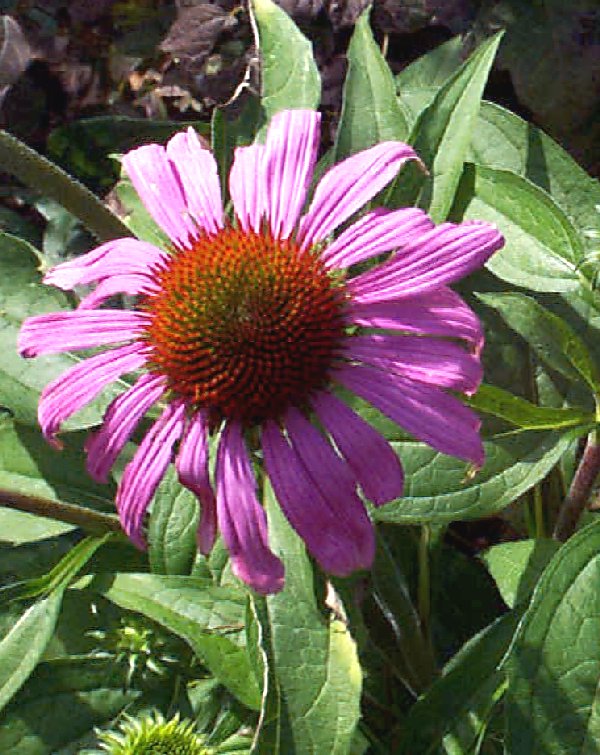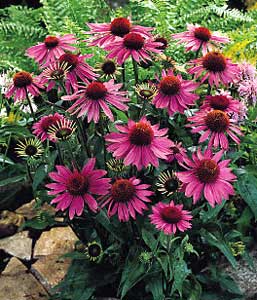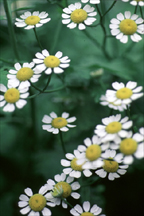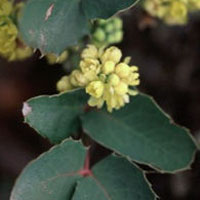 |
Echinacea Purpurea |
By Paul McCarthy
You can take too much, take the wrong kind, or take it for the wrong reason. Here are the facts.
Echinacea is beginn ing to rival aspirin in the over-the-counter medicine popularity contest. Indeed, in the herbal industry, echinacea has long been the number-one seller. However, despite its widespread appeal, echinacea has its limitations. First of all, it's not a panacea; it can only work against certain ailments at certain times. And second, not all echinacea products are potent.
To make sure you know the whats, whens, and hows of echinacea, we combed through the research and checked in with the experts. Here are their answers to the most common consumer questions about echinacea.
What is echinacea proven to do?
Echinacea's best documented benefit is its ability to both prevent colds and flus and help the body fight off those viral infections. According to Germany's foremost echinacea researcher, Rudy Bauer, Ph.D., echinacea protects the body against infection in several ways. Bauer, who is a professor of pharmaceutical biology at Heinrich-Heine University in Dusseldorf, says that polysaccharides, an active component of echinacea, have been found to boost the immune system by stimulating the activity of macrophages (a type of white blood cell). These cells engulf bacteria, viruses, and cellular debris, essentially acting as garbage collectors for the body. This process is known as phagocytosis. Echinacea also increases the production of T lymphocytes (another type of white blood cell).
Echinacea can continue to protect you once you've been exposed to a virus by blocking virus receptors on cells' surfaces so that the viruses are unable to take hold. It may also inhibit the production of an enzyme produced by viruses to make cell walls permeable, allowing them to invade.
There are inklings that echinacea may offer help with other ailments as well, such as yeast infections, skin irritations, and possibly cancer.
1. One study found that a preparation of Echinacea purpurea, one of the three most commonly sold echinacea species, increased phagocytosis against Candida albicans yeast up to 45 percent.
2. Several uncontrolled clinical studies demonstrated that echinacea is effective in the treatment of minor skin wounds and inflammations. In one large study, 85 percent of the 4,598 participants experienced improvement of their skin disorders, which included eczema, burns, wounds, and herpes simplex. (In Germany, echinacea is officially approved by the German government for external use on minor skin wounds.)
3. E. purpurea has been found in a limited number of studies to be effective against tumor cells, and at least one study, in Freiburg, Germany is underway to evaluate echinacea as an adjunct therapy in cancer treatment.
When should I take it for a cold or flu?
Steven Foster, author of Echinacea: Nature's Immune Enhancer (Healing Arts Press, 1991), says echinacea works best when symptoms of a cold or flu first appear. But you're not totally out of luck if you miss those early warning signs—sore throat, achiness, sniffles. Gail Mahady, Ph.D., who recently reviewed the world's scientific literature on echinacea for the World Health Organization, says echinacea will shorten the duration of a cold even if you take it after you've fallen sick.

Echinacea purpurea
Experts' opinions vary on how long you should take echinacea. Foster says to take it for three to five days. If symptoms persist or recur then take it for another three to five days. Donald Brown, N.D., from Seattle, Washington, recommends taking it for up to fourteen days. Your best bet is to try taking it for different amounts of time to find out what works best for you.
What form_capsule, tablet, tincture, tea_is most effective?
If you've been to a health foods store lately, you know that echinacea comes in many forms: crude plant in ground or powdered form, capsules and tablets; alcohol-based, glycerin-based, and water-based extracts (also known as tinctures); and various teas. And all of these can be made from different species of echinacea, the most common ones being purpurea, angustifolia, or pallida. These species differ in color, and height, as well as chemical composition. (There are seven known chemical components in all echinacea species.) Let's start with the question of which form is best.
There is no consensus on which preparation is the best, but some experts consider the fresh-pressed juice the most effective because of its range of active compounds. However, fresh-pressed juice has virtually no shelf life and so most manufacturers don't produce it. If you're really industrious, and have access to fresh echinacea, you can make your own. If not, alcohol-based liquid extracts are your best choice. "The alcohol in the mixture renders the medicinal components highly soluble," says Debra Reuben, chemical herbalist and owner of Dancing Willow Herbs, a manufacturer in Durango, Colorado.
As for which species to select, studies have shown that different chemical components are more concentrated in the different species, but no species is clearly superior. For instance, E. angustifolia and E. purpurea both contain higher concentrations of alkylamides than the pallida species. Some studies show E. angustifolia produces the most immune-boosting activity, while others have demonstrated E. purpurea enhances phagocytosis more. According to Rudy Bauer, all three types can be effective at fighting colds and flus. To cover your bases, you may want to buy a brand that combines the different varieties.
Experts also differ on the dosage they recommend. Here are general recommendations for the most effective preparations: Pressed juice: 2-3 dropperfuls three times daily; Tincture: 3-4 dropperfuls three times daily.
How do you know it's potent?
There are two ways you can ensure you are buying a quality product:
First, check the label for a manufacturing date, says Christopher Hobbs, author of The Echinacea Handbook (Eclectic Medical Publications, 1989). That way you'll know how much time has passed since the product was processed. Hobbs says tinctures last two to three years, powdered herbs in capsules about six months to a year.
And second, Steven Foster recommends checking the label for the ingredients.
There have been instances of some companies using roots from a plant that looks similar to echinacea, called Parthenium integrifolium, as a base for their products. Foster says if P. integrifolium or "Missouri Snake Root" appear on the label, you should avoid the product.
One popular way to check for potency—the tongue tingling test—isn't exactly surefire. The tingling is caused by the alkylamides found in angustifolia and purpurea. E. pallida does not have high concentrations of alkylamides, yet can still be potent.
Does it work well with other herbs?
There has been some clinical research in Germany on the effects of combining echinacea with other immune-stimulating herbs. One product called Esberitox combines echinacea with wild indigo (Baptisia tinctoria) and white cedar (Thuja occidentalis), and has been shown to be effective in treating conditions like skin infections, upper respiratory infections, colds, and influenza. Tests showed the combination of herbs was more effective than echinacea alone. However, many of the herbs experimented with in Germany are not available in the U.S.
There are products available that combine echinacea with goldenseal. However, goldenseal has never been proven effective in treating colds or flu.
Should I take it throughout the whole winter to prevent a cold?
A German study published in Planta Medica (a journal of medicinal plant research) found that mouse cells treated with E. purpurea four to six hours before being exposed to a virus showed up to 80 percent resistance. The cells stayed protected for approximately 24 hours after. This would indicate that taking echinacea continually would keep you from getting sick.
In general, however, unless your immune system is depressed, continual administration is not necessary. (If your immune system is compromised, you should probably discuss your options for enhancing it with your healthcare practitioner.) And most experts agree that echinacea seems to lose its punch if taken for more than eight weeks straight. If you do decide to use it continually, give yourself a one-week break every two months.
Do I have to worry about toxicity?
No toxicity has been found with normal use of echinacea, according to Mahady Still, there are a few instances where caution should be used. Pregnant or lactating women should not use echinacea; a strong tincture of echinacea should not be applied directly to a severe sore throat; and children should not take tinctures containing alcohol (instead they should take a glycerin-based extract). And people who are allergic to daisies may want to avoid echinacea, as it has caused allergic reactions in those individuals.
Should I look for a standardized product?
In theory, standardization seems like a great way for consumers to know they are getting a potent product. When a product says "standardized," it means the manufacturer guarantees that their product contains a set amount of an isolated chemical constituent of the herb that's been found to have therapeutic properties. Unfortunately, with echinacea, it's not known exactly which of the active compounds are most responsible for the benefits. It may be that they all play a role in boosting immunity, and to standardize just one or two may be misleading.

Feverfew
Paul McCarthy is a freelance writer in Littleton, Colorado.
Reprinted with permission from Natural Health, January-February 1998 issue. For a trial issue of Natural Health, call 1-800-526-8440.

Oregon Grape